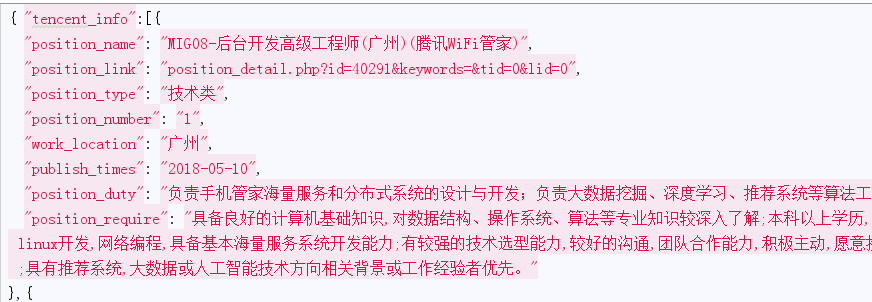案例1:爬取内容存储为一个文件
1.建立项目
C:pythonStudyScrapyProject>scrapy startproject tenCent New Scrapy project 'tenCent', using template directory 'c:\program files\pytho n36\lib\site-packages\scrapy\templates\project', created in: C:pythonStudyScrapyProject enCent You can start your first spider with: cd tenCent scrapy genspider example example.com
2.编写item文件
import scrapy class TencentItem(scrapy.Item): # define the fields for your item here like: # name = scrapy.Field() # 职位名称 position_name = scrapy.Field() # 详情链接 position_link = scrapy.Field() # 职位类别 position_type = scrapy.Field() # 职位人数 position_number = scrapy.Field() # 职位地点 work_location = scrapy.Field() # 发布时间 publish_times = scrapy.Field() # 工作职责 position_duty = scrapy.Field() # 工作要求 position_require = scrapy.Field()
3.建立spider文件
C:pythonStudyScrapyProject enCent enCentspiders>scrapy genspider tencent "hr.tencent.com" Created spider 'tencent' using template 'basic' in module: tenCent.spiders.tencent
编写spider类逻辑
from tenCent.items import TencentItem class TencentSpider(scrapy.Spider): name = 'tencent' allowed_domains = ['hr.tencent.com'] base_url = 'https://hr.tencent.com/' start_urls = ['https://hr.tencent.com/position.php'] def parse(self, response): node_list = response.xpath('//tr[@class="even"] | //tr[@class="odd"]') # 选取所有标签tr 且class属性等于even或odd的元素 next_page = response.xpath('//a[@id="next"]/@href').extract_first() # 选取所有标签a且id=next,href属性值 for node in node_list: ''' 实例化对象要放在循环里面,否则会造成item被多次赋值, 因为每次循环完毕后,请求只给了调度器,入队,并没有去执行请求, 循环完毕后,下载器会异步执行队列中的请求,此时item已经为最后一条记录, 而详细内容根据url不同去请求的,所以每条详细页是完整的, 最终结果是数据内容为每页最后一条,详细内容与数据内容不一致, 在yield item后,会把内容写到pipeline中 ''' item = TencentItem() item['position_name'] = node.xpath('./td[1]/a/text()').extract_first() # 获取第一个td标签下a标签的文本 item['position_link'] = node.xpath('./td[1]/a/@href').extract_first() # 获取第一个td标签下a标签href属性 item['position_type'] = node.xpath('./td[2]/text()').extract_first() # 获取第二个td标签下文本 item['position_number'] = node.xpath('./td[3]/text()').extract_first() # 获取第3个td标签下文本 item['work_location'] = node.xpath('./td[4]/text()').extract_first() # 获取第4个td标签下文本 item['publish_times'] = node.xpath('./td[5]/text()').extract_first() # 获取第5个td标签下文本 # yield item 注释yield item ,因为detail方法中yield item会覆盖这个 yield scrapy.Request(url=self.base_url + item['position_link'] ,callback=self.detail,meta={'item':item}) # 请求详细页,把item传到detail # 请求给调度器,入队,循环结束完成后,交给下载器去异步执行,返回response yield scrapy.Request(url=self.base_url + next_page,callback=self.parse) # 请求下一页 def detail(self, response): """ 爬取详细内容 :param response: :return: """ print("-->detail") item = response.meta['item'] # 得到parse中的yield item item['position_duty'] = ''.join(response.xpath('//ul[@class="squareli"]')[0].xpath('./li/text()').extract()) # 转化为字符串 item['position_require'] = ''.join(response.xpath('//ul[@class="squareli"]')[1].xpath('./li/text()').extract()) # 转化为字符串 yield item
4.建立pipeline文件
存储数据
# -*- coding: utf-8 -*- # Define your item pipelines here # # Don't forget to add your pipeline to the ITEM_PIPELINES setting # See: https://doc.scrapy.org/en/latest/topics/item-pipeline.html import json class TencentPipeline(object): def open_spider(self, spider): """ # spider (Spider 对象) – 被开启的spider # 可选实现,当spider被开启时,这个方法被调用。 :param spider: :return: """ self.file = open('tencent.json', 'w', encoding='utf-8') json_header = '{ "tencent_info":[' self.count = 0 self.file.write(json_header) # 保存到文件 def close_spider(self, spider): """ # spider (Spider 对象) – 被关闭的spider # 可选实现,当spider被关闭时,这个方法被调用 :param spider: :return: """ json_tail = '] }' self.file.seek(self.file.tell() - 1) # 定位到最后一个逗号 self.file.truncate() # 截断后面的字符 self.file.write(json_tail) # 添加终止符保存到文件 self.file.close() def process_item(self, item, spider): """ # item (Item 对象) – 被爬取的item # spider (Spider 对象) – 爬取该item的spider # 这个方法必须实现,每个item pipeline组件都需要调用该方法, # 这个方法必须返回一个 Item 对象,被丢弃的item将不会被之后的pipeline组件所处理。 :param item: :param spider: :return: """ content = json.dumps(dict(item), ensure_ascii=False, indent=2) + "," # 字典转换json字符串 self.count += 1 print('content', self.count) self.file.write(content) # 保存到文件
5.设置settiing
# Crawl responsibly by identifying yourself (and your website) on the user-agent USER_AGENT = '"User-Agent":"Mozilla/5.0 (Windows NT 6.1; Win64; x64) AppleWebKit/537.36 (KHTML, like Gecko) Chrome/63.0.3239.132 Safari/537.36"' # 头部信息,反爬 ITEM_PIPELINES = { 'tenCent.pipelines.TencentPipeline': 300, }
6.执行程序
C:pythonStudyScrapyProject enCent enCentspiders>scrapy crawl tencent
json文件


案例2:爬取内容存储为两个文件
案例2与只是把案例1中的概率页和详细内容页分成两个文件去存储,
只有某些py文件内容有变化,以下只列举出有变化的py文件
1.编写item文件
用两个类表示不同的存储内容
import scrapy """ 职位概览页字段 """ class TencentItem(scrapy.Item): # define the fields for your item here like: # name = scrapy.Field() # 职位名称 position_name = scrapy.Field() # 详情链接 position_link = scrapy.Field() # 职位类别 position_type = scrapy.Field() # 职位人数 position_number = scrapy.Field() # 职位地点 work_location = scrapy.Field() # 发布时间 publish_times = scrapy.Field() """ 职位详细页字段 """ class TenDetailItem(scrapy.Item): # 工作职责 position_duty = scrapy.Field() # 工作要求 position_require = scrapy.Field()
2.编写spider文件逻辑
# -*- coding: utf-8 -*- import scrapy from tenCent.items import TencentItem from tenCent.items import TenDetailItem print(__name__) class TencentSpider(scrapy.Spider): name = 'tencent' allowed_domains = ['hr.tencent.com'] base_url = 'https://hr.tencent.com/' start_urls = ['https://hr.tencent.com/position.php'] def parse(self, response): node_list = response.xpath('//tr[@class="even"] | //tr[@class="odd"]') # 选取所有标签tr 且class属性等于even或odd的元素 next_page = response.xpath('//a[@id="next"]/@href').extract_first() # 选取所有标签a且id=next,href属性值 for node in node_list: ''' 实例化对象要放在循环里面,否则会造成item被多次赋值, 因为每次循环完毕后,请求只给了调度器,入队,并没有去执行请求, 循环完毕后,下载器会异步执行队列中的请求,此时item已经为最后一条记录, 而详细内容根据url不同去请求的,所以每条详细页是完整的, 最终结果是数据内容为每页最后一条,详细内容与数据内容不一致, 在yield item后,会把内容写到pipeline中 ''' item = TencentItem() item['position_name'] = node.xpath('./td[1]/a/text()').extract_first() # 获取第一个td标签下a标签的文本 item['position_link'] = node.xpath('./td[1]/a/@href').extract_first() # 获取第一个td标签下a标签href属性 item['position_type'] = node.xpath('./td[2]/text()').extract_first() # 获取第二个td标签下文本 item['position_number'] = node.xpath('./td[3]/text()').extract_first() # 获取第3个td标签下文本 item['work_location'] = node.xpath('./td[4]/text()').extract_first() # 获取第4个td标签下文本 item['publish_times'] = node.xpath('./td[5]/text()').extract_first() # 获取第5个td标签下文本 yield item yield scrapy.Request(url=self.base_url + item['position_link'] ,callback=self.detail) # 请求详细页 # 请求给调度器,入队,循环结束完成后,交给下载器去异步执行,返回response # yield scrapy.Request(url=self.base_url + next_page,callback=self.parse) # 请求下一页 def detail(self, response): """ 爬取详细内容 :param response: :return: """ print("-->detail") item = TenDetailItem() # 实例化TenDetailItem item['position_duty'] = ''.join(response.xpath('//ul[@class="squareli"]')[0].xpath('./li/text()').extract()) # 转化为字符串 item['position_require'] = ''.join(response.xpath('//ul[@class="squareli"]')[1].xpath('./li/text()').extract()) # 转化为字符串 yield item
3.建立pipeline文件
存储数据
# -*- coding: utf-8 -*- # Define your item pipelines here # # Don't forget to add your pipeline to the ITEM_PIPELINES setting # See: https://doc.scrapy.org/en/latest/topics/item-pipeline.html import json from .items import TencentItem from .items import TenDetailItem """ 存储职位概览 """ class TencentPipeline(object): def open_spider(self, spider): """ # spider (Spider 对象) – 被开启的spider # 可选实现,当spider被开启时,这个方法被调用。 :param spider: :return: """ self.file = open('tencent.json', 'w', encoding='utf-8') json_header = '{ "tencent_info":[' self.count = 0 self.file.write(json_header) # 保存到文件 def close_spider(self, spider): """ # spider (Spider 对象) – 被关闭的spider # 可选实现,当spider被关闭时,这个方法被调用 :param spider: :return: """ json_tail = '] }' self.file.seek(self.file.tell() - 1) # 定位到最后一个逗号 self.file.truncate() # 截断后面的字符 self.file.write(json_tail) # 添加终止符保存到文件 self.file.close() def process_item(self, item, spider): """ # item (Item 对象) – 被爬取的item # spider (Spider 对象) – 爬取该item的spider # 这个方法必须实现,每个item pipeline组件都需要调用该方法, # 这个方法必须返回一个 Item 对象,被丢弃的item将不会被之后的pipeline组件所处理。 :param item: :param spider: :return: """ if isinstance(item,TencentItem): content = json.dumps(dict(item), ensure_ascii=False, indent=2) + "," # 字典转换json字符串 self.count += 1 print('content', self.count) self.file.write(content) # 保存到文件 ''' return item后,item会根据优先级 传递到下一个管道TenDetailPipeline处理 此段代码说明当实例不属于TencentItem时,放弃存储json, 直接传递到下一个管道处理 return放在if外面,如果写在if里面item在不属于TencentItem实例后, item会终止传递,造成detail数据丢失 ''' return item """ 存储职位详细情况 """ class TenDetailPipeline(object): def open_spider(self, spider): """ # spider (Spider 对象) – 被开启的spider # 可选实现,当spider被开启时,这个方法被调用。 :param spider: :return: """ self.file = open('tendetail.json', 'w', encoding='utf-8') json_header = '{ "tendetail_info":[' self.count = 0 self.file.write(json_header) # 保存到文件 def close_spider(self, spider): """ # spider (Spider 对象) – 被关闭的spider # 可选实现,当spider被关闭时,这个方法被调用 :param spider: :return: """ json_tail = '] }' self.file.seek(self.file.tell() - 1) # 定位到最后一个逗号 self.file.truncate() # 截断后面的字符 self.file.write(json_tail) # 添加终止符保存到文件 self.file.close() def process_item(self, item, spider): """ # item (Item 对象) – 被爬取的item # spider (Spider 对象) – 爬取该item的spider # 这个方法必须实现,每个item pipeline组件都需要调用该方法, # 这个方法必须返回一个 Item 对象,被丢弃的item将不会被之后的pipeline组件所处理。 :param item: :param spider: :return: """ if isinstance(item, TenDetailItem): ''' 得到item,判断item实例属于TenDetailItem,存储json文件 如果不属于,直接return item到下一个管道 ''' print('**'*30) content = json.dumps(dict(item), ensure_ascii=False, indent=2) + "," # 字典转换json字符串 self.count += 1 print('content', self.count) self.file.write(content) # 保存到文件 return item
4.设置settiing
# See https://doc.scrapy.org/en/latest/topics/item-pipeline.html ITEM_PIPELINES = { # 注册2个管道 'tenCent.pipelines.TencentPipeline': 300, 'tenCent.pipelines.TenDetailPipeline':400 # 数字越大,优先级越小,最后被执行 }
5.执行
#>scrapy crawl tencent >1.txt 2>&1 #把内容输出到文件中